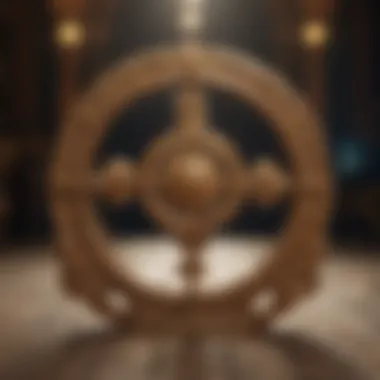Jatakam Match for Marriage: A Comprehensive Examination


Intro
Jatakam matching for marriage holds a significant place within the realm of Vedic astrology. This practice serves as a framework for assessing the compatibility between two individuals based on their birth charts, or Jatakams. This ancient method draws insights from celestial alignments and planetary influences at the time of birth, aiming to provide guidance on marital harmony and relational dynamics.
The concept of Jatakam matching is not merely superstition; it is grounded in a long tradition that intertwines astrological science with personal and cultural dimensions. Many people rely on these assessments to make informed choices about their partners, believing that the energies outlined in their horoscopes can affect their future together.
The Core Aspects of Jatakam Matching
- Astrological Principles: At the heart of Jatakam matching lies a detailed examination of planets, houses, and signs relevant to each person's Jatakams. These components reveal traits and compatibility levels.
- Compatibility Assessment: The evaluation is often broken down into several criteria, such as mental harmony, emotional support, and physical attraction. Each factor plays a role in determining the overall compatibility score.
- Benefits and Limitations: While Jatakam matching can provide valuable insights, it also has limitations. No astrological reading can guarantee marital success, and personal effort remains essential.
- Cultural Relevance: In many cultures, particularly in South Asia, Jatakam matching is a common practice. It encompasses both individual beliefs and community norms, providing a shared framework for potential partnerships.
This article will explore these facets in detail to equip the reader with a comprehensive understanding of Jatakam matching, thereby merging ancient wisdom with modern relationship needs.
Prologue to Jatakam Matching
The practice of Jatakam matching holds significant importance within Vedic astrology, especially when considering marriage. Understanding Jatakam is essential for those seeking harmony and compatibility in their partnerships. This section sets the stage for a deeper exploration of how astrological elements shape marital relationships, exhibiting critical elements that individuals must consider.
Defining Jatakam
Jatakam, often referred to as a birth chart or horoscope, is an astrological representation of an individual's time and place of birth. It provides insights into a person's characteristics, potential, and challenges. In the context of marriage, Jatakam becomes a tool for evaluating compatibility between two partners. These charts analyze the positions of celestial bodies at the time of birth and assess how these placements affect personal traits and relational dynamics.
The matching process involves comparing the Jatakams of both individuals. Key factors include the Moon sign, the Rising sign, and the placement of various planets. Each of these elements contributes to understanding how couples may interact, communicate, and overcome challenges in their relationship.
Cultural Context and Historical Background
The practice of Jatakam matching dates back over millennia and is deeply rooted in Indian culture. The ancient texts of Vedic astrology emphasize the importance of celestial influences on human affairs. Historically, marriages were often arranged, and families sought to ensure compatibility for social harmony and familial stability. Jatakam matching provided a framework that went beyond personal choice, integrating astrological insights into the decision-making process.
In modern times, while love marriages are more common, many still hold onto these traditional practices. Couples regard Jatakam matching as a way to seek a deeper understanding of their relationship, drawing upon time-honored beliefs and practices. This convergence of ancient wisdom with contemporary marital practices highlights the lasting influence and relevance of Jatakam matching today.
Jatakam matching not only guides individuals in their marital choices but serves as a reflection of cultural values.”
Understanding these foundational aspects of Jatakam matching leads to a greater comprehension of its role in facilitating meaningful and enduring relationships. Incorporating these insights enables individuals to make informed decisions, harmonizing astrology with personal experiences and preferences.
The Role of Astrology in Marriage
Astrology plays a pivotal role in the cultural practices surrounding marriage, particularly within the framework of Vedic astrology. Understanding the astrological aspects can enhance the longevity and harmony of marital relationships. Many individuals consult astrological charts as a means to attain clarity on compatibility and to foresee potential challenges.
In essence, astrology serves as a guiding tool that informs individuals about their partners' personalities, strengths, and weaknesses. It can help predict how two people will interact, which is vital for forming strong bonds. When assessing potential life partners using Jatakam matching, astrological principles are key.
Benefits of incorporating astrology into marriage discussions include:
- Enhanced understanding: Couples can gain insights into one another’s personalities based on their birth charts.
- Conflict resolution: Knowing astrological compatibility may provide foresight regarding potential disputes, allowing couples to navigate challenges more effectively.
- Support from tradition: For many, engaging in astrological practices aligns with cultural beliefs about marriage, contributing to community acceptance.
Considering these advantages, the importance of astrology cannot be overstated.
Astrological Principles and Marriage
Astrological principles rooted in Vedic systems focus on planetary positions and their influences. Each individual is born with a unique birth chart that maps the position of celestial bodies at the time of birth. These charts not only reveal personal traits but also how two people may relate to each other in a marital context.
Some core astrological principles include:
- Zodiac Signs: Each sign comes with distinct characteristics that can shape behaviors and preferences in relationships.
- Houses: The twelve houses represent various aspects of life, and their placement in a natal chart can affect marital dynamics.
- Aspects: The angles formed between different planets in the charts can influence compatibility, offering deeper understanding into relational strengths and weaknesses.
Astrological matching takes these factors into consideration to form a holistic view of compatibility. By evaluating the charts of prospective partners, one can predict the likelihood of a harmonious relationship or potential conflicts.
Understanding Compatibility as per Vedic Astrology


Compatibility in Vedic astrology goes beyond basic attraction; it delves into deeper emotional and psychological affiliations. One widely acknowledged aspect is the analysis of Guna Milan, which assesses compatibility based on eight factors. This systematic approach allows for a more structured evaluation of a couple's potential.
Key factors assessed in Guna Milan include:
- Varna: Relates to spiritual development and is crucial for social hierarchy compatibility.
- Vashya: Indicates control and attraction levels in the relationship.
- Tara: Deals with the overall well-being of both partners.
- Yoni: Examines sexual compatibility, which is essential for a fulfilling relationship.
The overall score from these assessments can yield valuable insights for prospective couples. Greater alignment is often correlated with a higher probability of marital satisfaction and stability.
The intricate balance of astrological factors serves as a compass for couples navigating the complex landscape of marital relationships.
Components of a Jatakam
Understanding the components of a Jatakam is crucial for effective matching in marriage. The Jatakam, also known as the birth chart, serves as a blueprint of an individual's life and potential. It reveals various elements that impact personality traits, preferences, and compatibility with another person. Therefore, recognizing these components allows astrologers to make informed decisions during the matching process.
Key Elements of a Birth Chart
A Jatakam consists of several key elements. Each plays a distinct role in shaping an individual's characteristics and relationships.
- Lagna (Ascendant): This is the sign that was rising at the time of birth. It influences a person's physical appearance and fundamental nature.
- Sun and Moon Signs: The positions of the Sun and Moon at the time of birth are vital. They represent the individual's essence and emotional responses, offering insights into their inner self and how they express feelings.
- Houses: Each of the twelve houses in a birth chart governs different aspects of life, such as career, love, relationships, and health. The planetary positions within these houses can indicate strengths or challenges in specific areas of life.
- Planets: The presence and positioning of planets in various signs and houses are critical in determining behavioral patterns and life experiences.
- Nakshatras: These are the lunar mansions that divide the zodiac into 27 segments. Each Nakshatra has unique attributes and influences, affecting compatibility significantly.
Recognizing these elements enables a deeper understanding of one’s character and potential relationship dynamics. The insights gained from the Jatakam can guide individuals in selecting partners whose charts synergize well with theirs, fostering long-lasting ties.
Planetary Positions and Their Significance
The positions of planets in a Jatakam have profound implications. Each planet's placement not only reveals traits but also highlights potential challenges.
- Venus: Known as the planet of love, Venus's position indicates what one seeks in a partner. A strong placement can signify romantic inclinations, while a weak position might highlight struggles in relationships.
- Mars: This planet influences passion and aggression. Its placement can show a person's approach to conflicts within relationships, helping assess compatibility.
- Jupiter: Associated with expansion and wisdom, Jupiter's position can indicate luck in partnerships and family life. A strong Jupiter can denote a supportive marital environment.
- Saturn: Often viewed as a planet of restriction and discipline, Saturn’s position can indicate areas where a person might face challenges or delays in their marital life.
Being aware of how these planetary positions affect an individual contributes to a more comprehensive analysis during Jatakam matching. The intricate dance of celestial bodies provides guidance that goes beyond mere compatibility, potentially transforming the trajectory of relationships.
"A well-rounded understanding of a Jatakam empowers individuals to navigate their love lives with clarity and foresight."
The Matching Process
The process of matching Jatakam charts for marriage stands as a pivotal aspect within the Vedic astrology framework. This procedure not only involves analyzing celestial positions but also encapsulates the intricate dynamics of human relationships. The efficiency of this matching process is grounded in its ability to discern compatibility factors, thereby facilitating informed decisions among individuals and families. It is crucial for ensuring both emotional and spiritual alignment between prospective partners.
Gathering Information
The initial step in the Jatakam matching process involves the meticulous gathering of relevant data. Key information includes the birth details of both individuals, specifically their date, time, and place of birth. These elements significantly influence the generation of accurate natal charts.
Moreover, it is beneficial to collect insights into each person’s personality, values, and family background. This broader context serves to enrich the astrological assessment. An accurate and comprehensive data collection enhances the reliability of the compatibility analysis, allowing astrologers to draw meaningful conclusions.
Conducting the Match
Once sufficient information is amassed, astrologers proceed to conduct the match. This step typically involves the use of software or traditional techniques to create both individuals’ Jatakam charts. The astrologer then examines the planetary placements and their respective aspects.
Compatibility is evaluated based on several key criteria, such as:
- Koota Matching: This includes analyzing Guna Milap, which examines inherent qualities and characteristics.
- Nadi Matching: This focuses on the Nadi point in each chart and determines if they align.
- Mangal Dosh: An evaluation of whether the presence of this dosh in either chart will affect the marriage.
Conducting this match systematically enables astrologers to highlight potential areas of happiness and challenge within the relationship.
Evaluating Compatibility
The final phase of the matching process involves a critical evaluation of compatibility. This step is crucial as it consolidates the findings from earlier phases into a cohesive analysis. It is not only about correlating astrological positions but also interpreting their implications in a marital context.


Factors considered during this evaluation include:
- Emotional Alignment: How well both individuals can understand and empathize with each other.
- Future Vision: Shared goals and aspirations that align with their individual life paths.
- Cultural Factors: The intersection of societal, religious, and familial expectations that may impact the marriage.
Ultimately, this comprehensive evaluation aims to provide both individuals and their families with a nuanced understanding of compatibility, helping them to make informed decisions about moving forward in their union.
The efficacy of Jatakam matching lies not just in astrological computations but also in the profound understanding of human nature and relationships.
In summary, the matching process in Jatakam astrology serves as a structured approach to assess potential marital compatibility, blending spiritual and practical considerations in a cohesive manner.
Factors Influencing Jatakam Matching
Understanding the factors influencing Jatakam matching is vital in assessing compatibility for marriage. Various elements can significantly impact the outcomes of astrological evaluations. By considering these factors, one can enhance the effectiveness of the matching process. This section will highlight the importance of Nakshatras and Dasha, two critical aspects in astrological analysis.
The Importance of Nakshatras
Nakshatras, or lunar mansions, play a critical role in Jatakam matching. Each Nakshatra is linked to specific characteristics and traits that influence personality and behavior. When assessing compatibility between potential partners, the Nakshatras of both individuals are examined carefully.
Factors concerning Nakshatras include:
- Compatibility: Certain Nakshatras are naturally harmonious, while others may conflict. A match between compatible Nakshatras often leads to a more cohesive relationship.
- Strengthening Bonds: Understanding the Nakshatras can help couples navigate challenges by leveraging their strengths.
- Cultural Significance: In many Indian traditions, Nakshatras are considered sacred. They hold profound meanings, enhancing the couples’ reservations and belief in astrological alignments.
Ultimately, Nakshatra compatibility serves as a guide to build a lasting connection between partners. It can set the tone for the overall relationship.
Dasha and Its Impact
Dasha refers to planetary periods that influence an individual's life at various stages. These periods are determined using the birth chart, revealing specific times when certain planetary energies dominate. In the context of Jatakam matching, understanding the Dasha of both partners is crucial for several reasons:
- Timing Assessment: Couples can use Dasha to identify auspicious periods for marriage and other significant life events. Being in the right Dasha can result in smoother marital dynamics.
- Individual Choices: Each Dasha brings a unique set of opportunities and challenges. A proper understanding aids partners in respecting each other's life's path.
- Conflict Management: If negative Dasha influences are present, couples can prepare for potential conflicts and better devise strategies to address them.
In summary, both Nakshatras and Dasha significantly influence the Jatakam matching process. They provide a deeper understanding of compatibility, timings, and personal growth in relationships. Paying attention to these factors enriches the overall experience and provides clarity in astrological consultations.
Benefits of Jatakam Matching
In the realm of Vedic astrology, Jatakam matching serves as a pivotal tool for assessing marital compatibility. Understanding its benefits not only illuminates the intricacies of emotional bonds but also highlights how astrology informs personal decisions. Within this framework, the concept emerges as an ancient practice that evolves continuously, intertwining with modern life and its complexities.
Facilitating Harmonious Relationships
The primary benefit of Jatakam matching is its potential to cultivate harmonious relationships. By analyzing the birth charts of both individuals, astrologers can identify strengths and weaknesses. These insights extend beyond mere compatibility; they provide a roadmap for navigating interpersonal dynamics.
Key elements considered include:
- Nakshatras: These lunar constellations influence personality traits and emotional responses, shaping how partners interact.
- Lagna: The ascendant sign influences behavior in relationships, dictating initial impressions and reactions.
- Venus and Mars placements: These planets inform romantic inclinations and conflict resolution styles.
By aligning these elements, couples can foster mutual respect and understanding, reducing friction in daily life. Relationships underpinned by astrological compatibility often report deeper emotional bonds and enhanced communication, vital for long-term success.
Reducing Marital Conflicts
Another significant advantage of Jatakam matching is its role in reducing marital conflicts. Disagreements are an inherent part of any relationship; however, when partners understand their compatibility, they can address potential issues proactively. The astrological analysis highlights aspects that may cause friction, allowing couples to prepare and manage conflicts skillfully.
Considerations include:
- Planetary afflictions: Challenging planetary aspects can indicate potential areas of concern.
- Dasha periods: These planetary timeframes signify phases in life that can impact relational stability.
- Chakra analysis: By performing a thorough analysis of energy centers, astrologers can identify imbalances that may lead to misunderstandings.
After identifying these parameters, couples can implement strategies to mitigate negative influences, fostering a supportive environment that encourages growth over discord. Astrological insights create a framework for constructive dialogue, empowering couples to approach conflicts with empathy.


"Astrology’s wisdom allows couples to navigate through the complexities of relationships with increased awareness, leading to a fulfilling partnership."
Limitations of Jatakam Matching
While Jatakam matching offers valuable insights into marital compatibility, it is essential to recognize its limitations. Understanding these constraints is crucial for anyone looking to rely on astrological frameworks. This section digs into common misconceptions and the potential pitfalls that may arise from an overreliance on astrological guidance.
Addressing Misconceptions
There exists a plethora of misconceptions surrounding Jatakam matching. Many people tend to believe that a perfect match can be guaranteed solely based on the astrological chart. This is not entirely accurate. While Jatakam matching utilizes intricate calculations and ancient wisdom, it does not account for the myriad of personal, social, and emotional factors that play a role in human relationships.
For instance, individuals often assume that the placement of planets will definitively indicate future marital success. In reality, even with favorable planetary positions, unforeseen circumstances can create challenges in a marriage.
Moreover, some might think that Jatakam matching eliminates the need for personal effort in a relationship. However, no astrological analysis can substitute for the essential personal commitment and mutual understanding required for a successful partnership. Evaluating each individual’s birth chart should be seen as a guiding tool rather than an absolute determinant.
Overreliance on Astrological Guidance
The reliance on astrological guidance in Jatakam matching can lead to certain risks.
- Individuals may dismiss potential partners who do not match their astrological criteria.
- This can result in missed opportunities for meaningful relationships that could develop outside the astrological forecast.
Additionally, the overemphasis on compatibility based on Jatakam matching can inadvertently cause anxiety. People may start to perceive any deviations from the suggested matches as indicators of a doomed relationship.
Astrology, while influential, should supplement, not dictate, one's choices in relationships. Couples must evaluate their partnership holistically, considering factors like communication, shared interests, and emotional support alongside their astrological compatibility.
"Astrology provides insights; it does not dictate the course of our relationships."
Lastly, placing too much weight on astrological insights can lead to a disconnection from the realities of human interaction. Relationships often flourish through personal growth, shared experiences, and emotional investments. Thus, one must approach Jatakam matching and subsequent guidance with a balanced mindset that acknowledges its limitations while still valuing its insights.
Modern Perspectives on Jatakam Matching
The discussion surrounding Jatakam matching has evolved significantly in recent times. As society advances, the role of astrology, particularly in marriage, has found new relevance. Understanding modern perspectives offers insights into how people integrate tradition within contemporary contexts. Some recognize Jatakam matching as an ancient practice rather than a rigid set of rules. They see it as guidance that needs to be contextualized with today's dynamics. This approach encourages a more flexible interpretation of astrological compatibility, allowing individuals to make informed choices without feeling overly constrained by tradition.
Integration of Astrology in Contemporary Culture
Astrology, particularly Vedic astrology, maintains a substantial place in contemporary culture. Many individuals now seek astrological advice not just for compatibility but for overall guidance in life choices. This shift highlights a broader acceptance of astrology in personal and social contexts. Young generations often turn to astrologers for insights related to careers, relationships, and even daily routines, indicating a culture that values celestial influences.
- Cultural Embrace: Astrology finds a foothold in modern rituals, wedding planning, and decision-making processes.
- Wellness and Mindfulness: Many incorporate astrological insights as part of health and wellness practices. This holistic approach promotes a deeper understanding of oneself and one’s partner.
The blend of tradition with contemporary culture serves as a bridge connecting ancient wisdom with modern living.
The Role of Technology in Astrological Consultations
Technology has revolutionized the way people access astrological consultations. In the past, seeking guidance required visits to astrologers; now, mobile apps and websites facilitate this process. These platforms offer services like birth chart analysis, daily horoscopes, and even live consultations through videos. This accessibility empowers individuals to explore astrological insights without intimidation.
- Ease of Access: The convenience of online resources allows more people to understand their Jatakam and its implications for marriage.
- Community Building: Online forums and social networks provide spaces where individuals can share experiences and seek advice, fostering a sense of community around astrology.
- Personalization: Advanced algorithms in apps analyze users’ specific data, providing personalized advice and creating tailored compatibility reports.
The End
The conclusion of this article presents crucial insights regarding the practice of Jatakam matching within the context of Vedic astrology. As explored throughout the various sections, Jatakam matching encompasses a blend of cultural relevance, astrological principles, and practical implications for marital compatibility. The significance of understanding one's Jatakam cannot be overstated, as it serves as a guiding framework for many individuals seeking successful unions.
Summarizing Key Insights
In summary, the core aspects of Jatakam matching are multifaceted. These include:
- Cultural Tradition: Rooted in centuries of Vedic practices, Jatakam matching supports societal norms regarding marriage.
- Astrological Foundations: The analysis of planetary positions and Nakshatras provides the basis for compatibility assessments.
- Practical Benefits: By identifying strengths and weaknesses in potential partnerships, Jatakam matching aids individuals in making informed decisions about their marital prospects.
The integration of astrological guidance with modern relationship dynamics enrich this ancient practice, continuing its relevance today.
Future of Jatakam Matching
Looking forward, the future of Jatakam matching appears bright, particularly with advancements in technology. Many astrologers are leveraging digital platforms to streamline consultations, making it more accessible to a global audience. Increased awareness of astrological principles will likely inspire further acceptance of Jatakam matching across diverse cultures.
Moreover, as contemporary society navigates through evolving relationship paradigms, the individualized nature of Jatakam assessments can adapt accordingly. Therefore, the continued educational efforts in promoting astrological literacy will empower future generations to engage with these traditions meaningfully. Once combined with modern perspectives, Jatakam matching can find its place in a broader framework, allowing it to flourish alongside contemporary marital practices.







